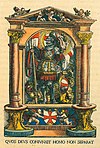Swabian League

The Swabian League (Schwäbischer Bund) was a mutual defence and peace keeping association of
The religious revolution of the
History
The Swabian League was established in 1488 at the behest of Emperor
On 14 February 1488, a new Swabian League was formed, at the Reichstag of
After the death of
The League defeated an alliance of robber barons in the Franconian War in 1523. Next it helped to suppress the Peasants' Revolt in 1524–26, including its defeat and execution of Little Jack (Jaecklein) Rohrbach, and crushing the Black Company in its last stand at the Battle of Ingolstadt in May 1525.
The religious revolution of the
Members
 Sigismund of Habsburg, Count of Tyrol and Archduke of Further Austria, followed by Archduke Maximilian I of Habsburg in 1490
Sigismund of Habsburg, Count of Tyrol and Archduke of Further Austria, followed by Archduke Maximilian I of Habsburg in 1490 Eberhard V, Count of Württemberg (raised to a duke in 1495), succeeded by Duke Eberhard II in 1496
Eberhard V, Count of Württemberg (raised to a duke in 1495), succeeded by Duke Eberhard II in 1496
joined by several princes of the Empire until 1489:
 Frederick II of Hohenzollern, Prince-Bishop of Augsburg
Frederick II of Hohenzollern, Prince-Bishop of Augsburg- Christopher I, Margrave of Baden
 George Frederick of Hohenzollern, Margrave of Brandenburg-Ansbach
George Frederick of Hohenzollern, Margrave of Brandenburg-Ansbach Siegmund of Hohenzollern, Margrave of Brandenburg-Bayreuth
Siegmund of Hohenzollern, Margrave of Brandenburg-Bayreuth- Mainz and Prince-elector
- Trierand Prince-elector
extended after 1500 by its former opponent:
 Albert IV of Wittelsbach, Duke of Bavaria-Munich, Duke of re-united Bavaria from 1503.
Albert IV of Wittelsbach, Duke of Bavaria-Munich, Duke of re-united Bavaria from 1503.
In 1512 Baden and Württemberg left the league, while the
 Philip I, Landgrave of Hesse in 1519
Philip I, Landgrave of Hesse in 1519- Electorate of the Palatinate, Prince-elector as well as
- Philip of Wittelsbach, Counts Palatine of Palatinate-Neuburgand
- Würzburgin 1523 and finally
- Salzburgin 1525.
Notes
This article includes a list of general references, but it lacks sufficient corresponding inline citations. (February 2014) |
- ISBN 3-87181-424-5. p. 453
- ^ Laffan 1975:198.
- ^ R.G.D. Laffan, "The Empire under Maximilian I", in The New Cambridge Modern History, vol. I 1975:198.
- ^ Laffan 1975:198.
- Attribution
- This article incorporates text from a publication now in the public domain: Alfred Bradley Gough (1911). "Swabian League". In Chisholm, Hugh (ed.). Encyclopædia Britannica (11th ed.). Cambridge University Press.
Further reading
- Close, Christopher W. "Estate Solidarity and Empire: Charles V's Failed Attempt to Revive the Swabian League." Archiv für Reformationsgeschichte (2013) 104#1 pp 134–157, in English.

